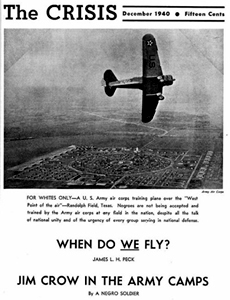
Black MP in Columbus, GA, 1942
Source: National Archives
Blacks protested segregation on post, in the exchanges and the restaurants. As early as spring 1942, at Tuskegee Field, two black airmen tried to shop in the white section of the post exchange and refused to leave until ordered to do so. Blacks also targeted segregated on-post recreational facilities at Robbins Field in Georgia, at Maxwell Field in Alabama, at George Field in Illinois, at Laurinburg-Maxton Field in North Carolina, at Hill Field in Utah, at Langley Field in Virginia, and at Gulfport in Mississippi. At the post exchange at Robbins Field, Georgia, a black soldier tried to use the "white" restroom and was escorted out of the store. At Tuskegee Field, twelve black officers permanently integrated the post exchange restaurant; white officers responded by eating elsewhere. At Gunter Field, Alabama, a black enlisted man presented a copy of the Army directive requiring desegregated facilities to his section commander.1
Blacks protested segregation in on-post movie theaters. At Cochran Field in Georgia, a black soldier sat in the "white" section of the post theater until officials asked him to leave. On its way to Europe, the 332nd Fighter Group desegregated an on-post movie theater by brandishing their handguns when threatened by the proprietor. An Army report noted that at Walterboro Air Base, black soldiers refused to attend movies until segregated seating was abolished. A black sailor wrote an article for the Crisis magazine of the National Association of Colored People (NAACP), explaining that blacks at Navy bases like Norfolk were forced to sit in segregated balconies. A black soldier wrote another article for the Crisis months later noting segregation in post theaters, libraries, exchanges, and buses and explaining that dissatisfaction had led to a number of altercations over the segregation policies.2

Cover from NAACP Crisis Magazine, Dec. 1940
Source: NAACP
